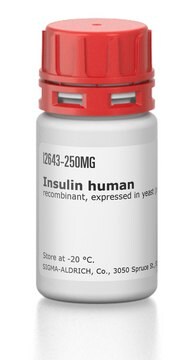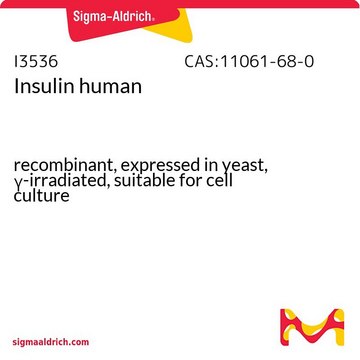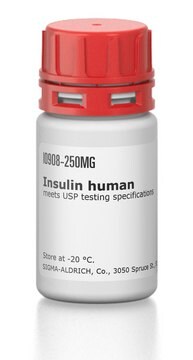91077C
Insulin, Human Recombinant
for research or for further manufacturing use, dry powder
Synonym(s):
Insulin sodium salt human, rh-Insulin
About This Item
Recommended Products
Quality Level
form
dry powder
potency
≥27.5 units per mg
technique(s)
cell culture | mammalian: suitable
impurities
≤1.0 EU/mL endotoxin
solubility
water: 10 mg/mL (pH 2.0—2.5)
UniProt accession no.
shipped in
ambient
storage temp.
−20°C
InChI key
PBGKTOXHQIOBKM-FHFVDXKLSA-N
Gene Information
human ... INS(3630)
Looking for similar products? Visit Product Comparison Guide
General description
Application
- Recombinant Human Insulin has been used in the media for adipogenic induction of mesenchymal stem cells.
- It has been used as a supplement in the cell culture media of airway epithelial cells.
- It has been used in the culture media for differentiation of cells, GLUT4 (glucose transporter type 4) translocation assay and to study interaction of insulin with insulin receptor via surface plasmon resonance.
Biochem/physiol Actions
Other Notes
related product
Storage Class Code
11 - Combustible Solids
WGK
nwg
Flash Point(F)
Not applicable
Flash Point(C)
Not applicable
Personal Protective Equipment
Choose from one of the most recent versions:
Certificates of Analysis (COA)
It looks like we've run into a problem, but you can still download Certificates of Analysis from our Documents section.
If you need assistance, please contact Customer Support.
Already Own This Product?
Find documentation for the products that you have recently purchased in the Document Library.
Customers Also Viewed
Our team of scientists has experience in all areas of research including Life Science, Material Science, Chemical Synthesis, Chromatography, Analytical and many others.
Contact Technical Service









